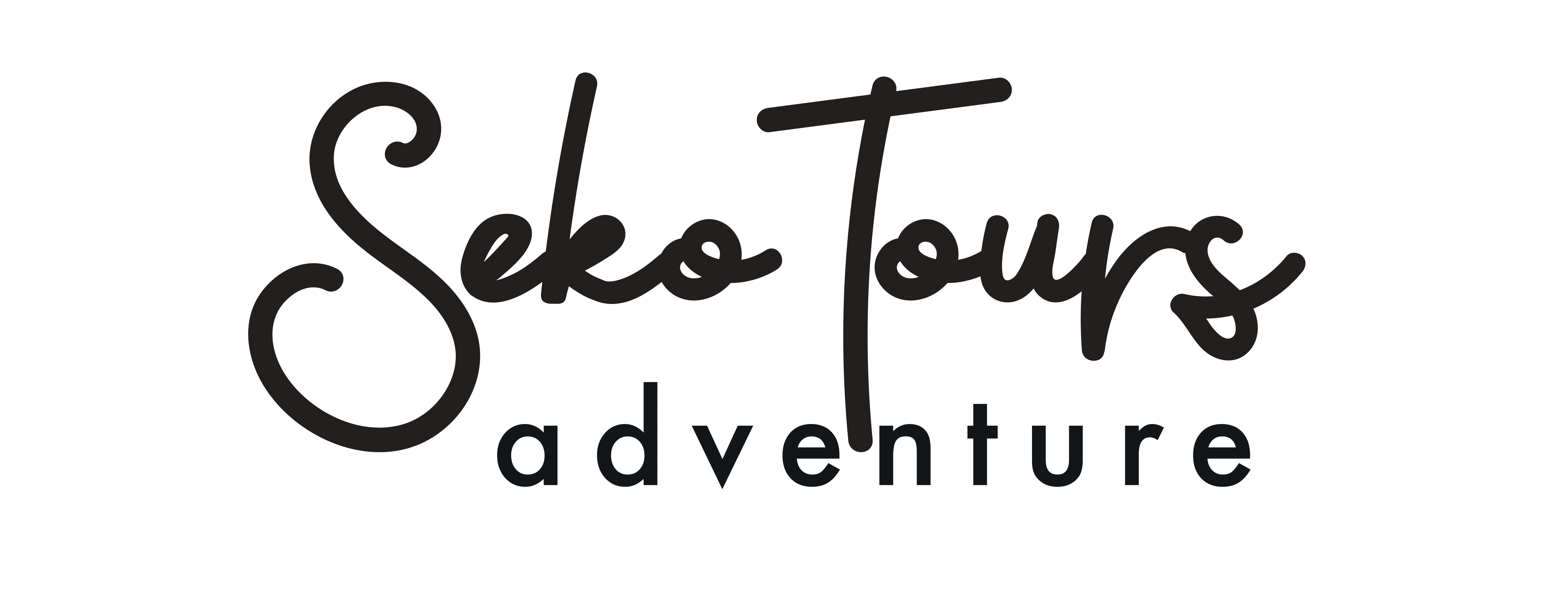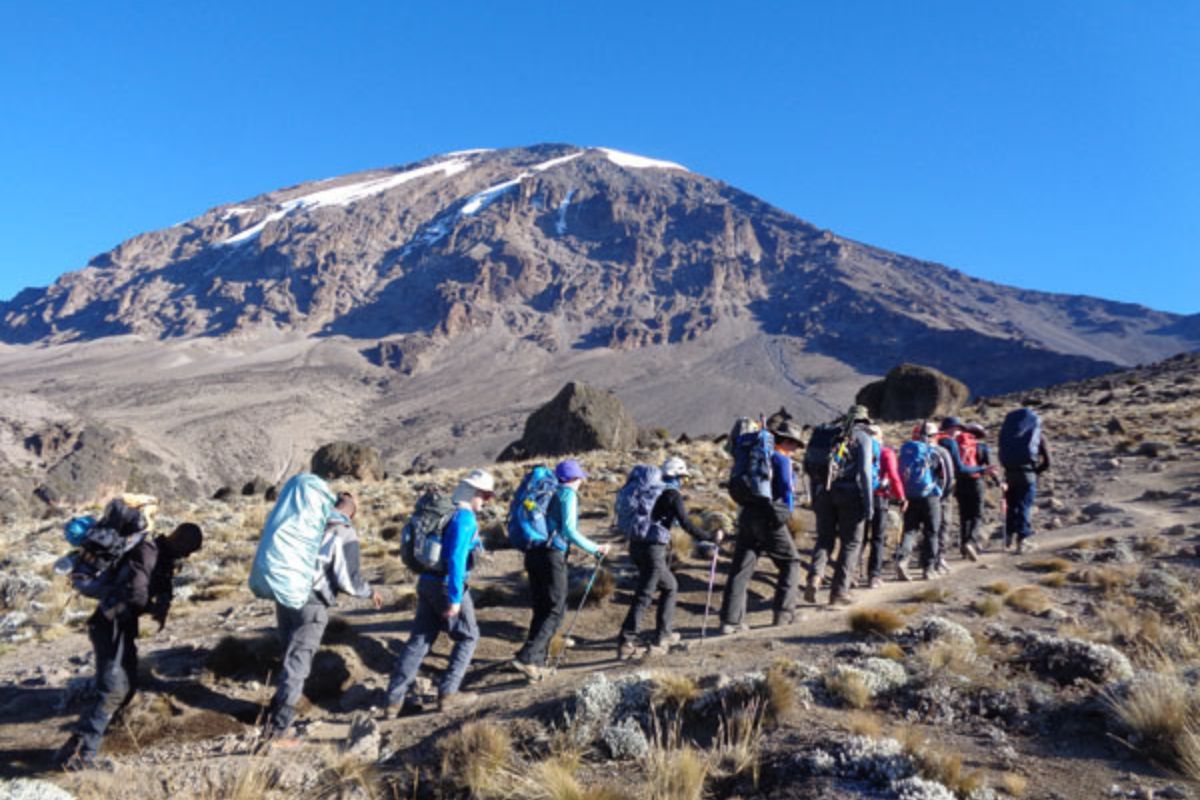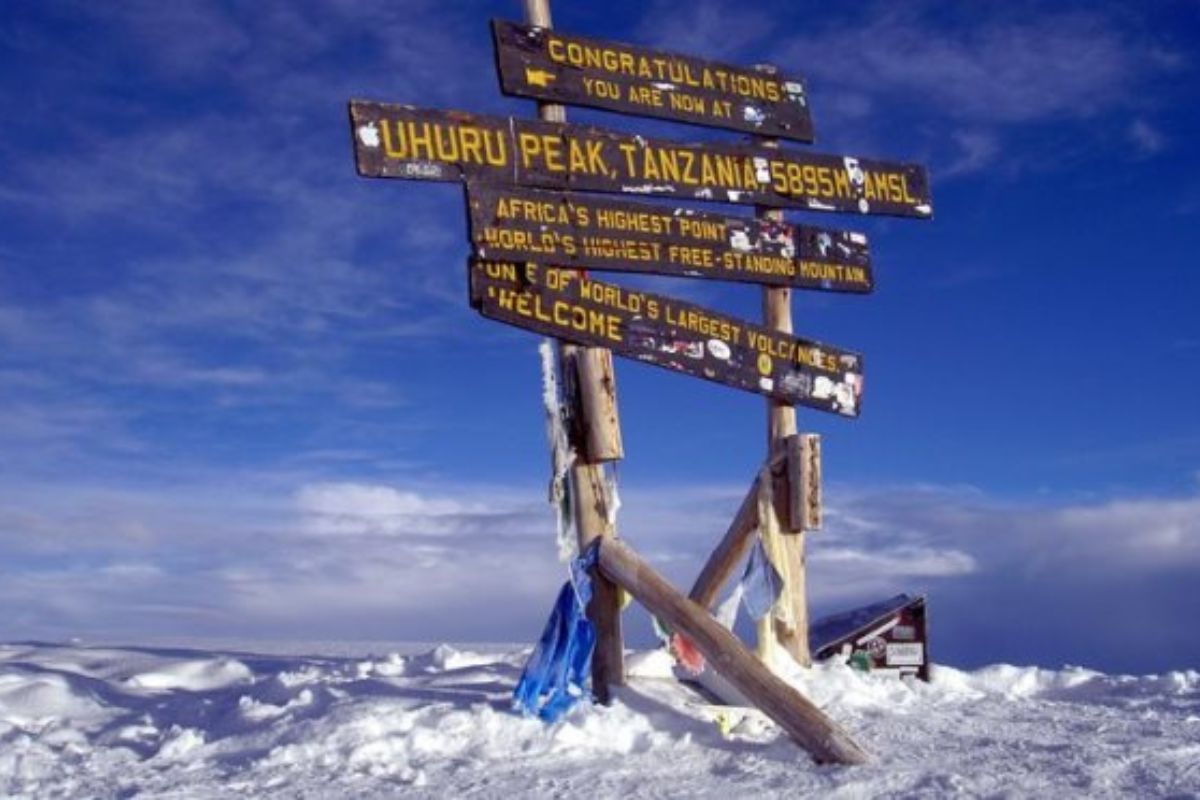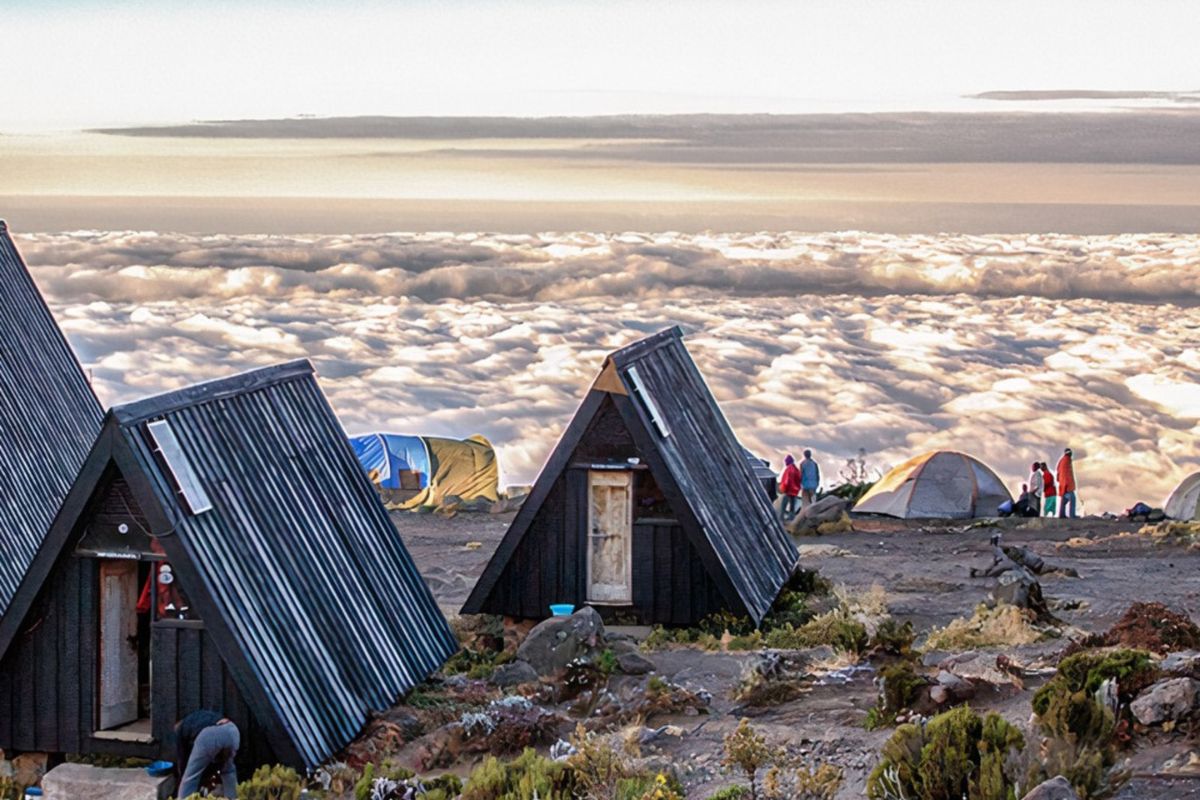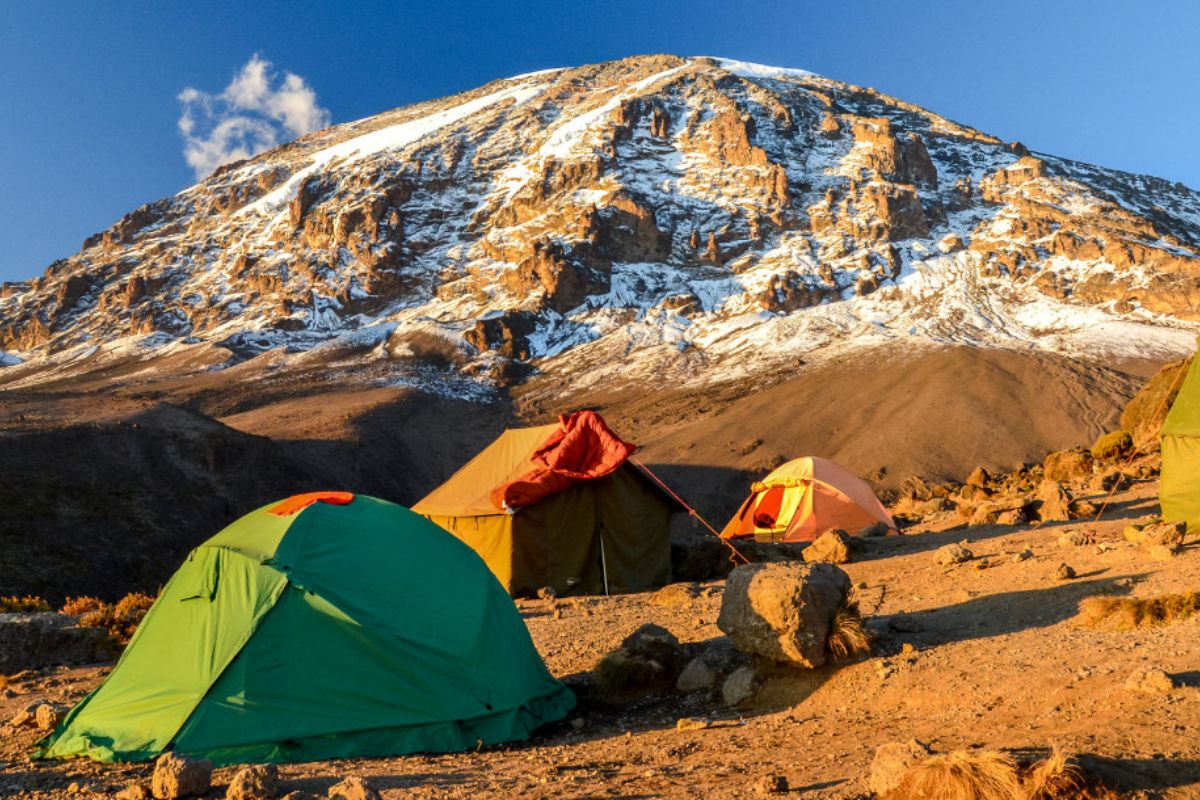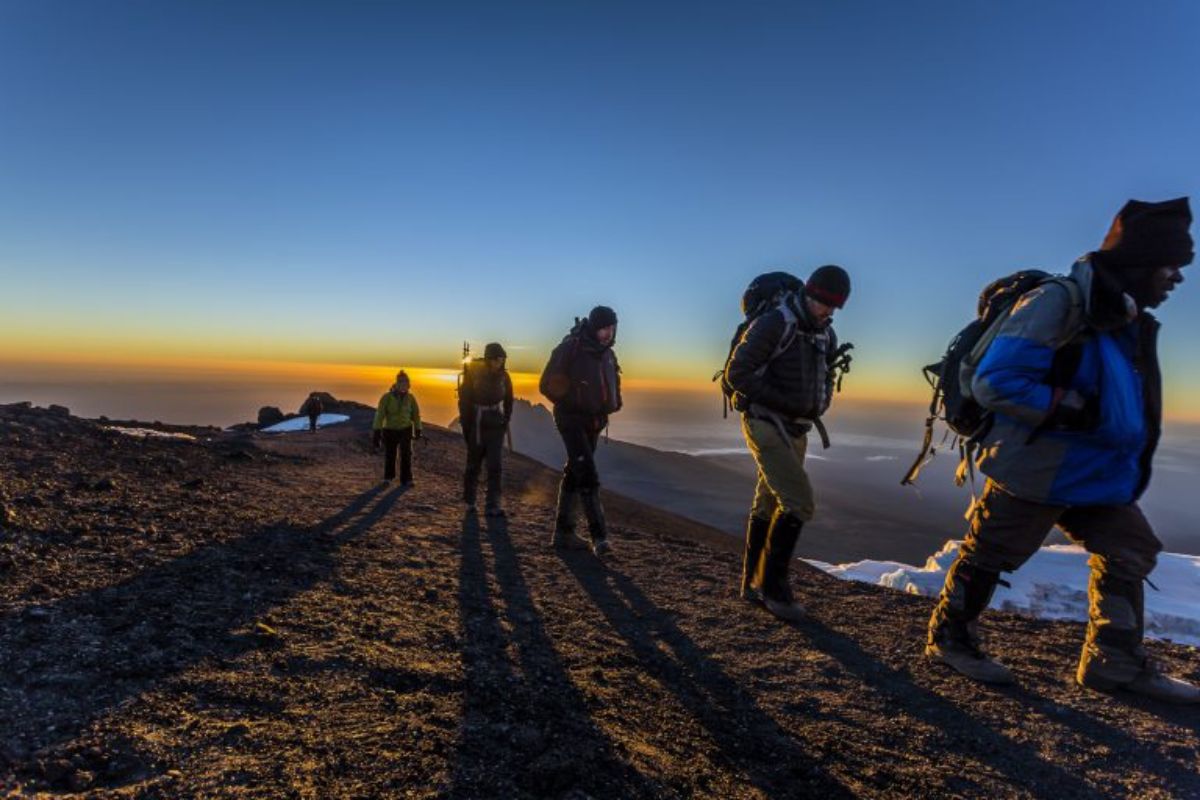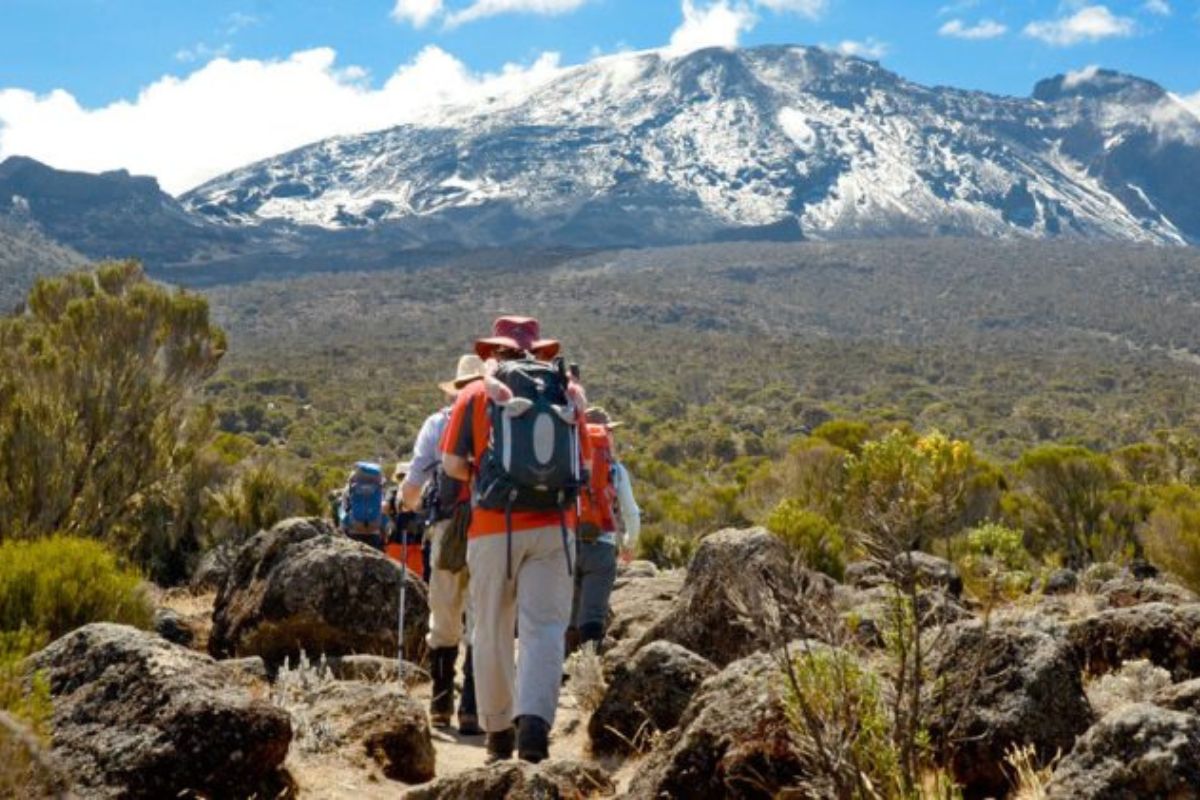Explore Tanzania
Climbing Kilimanjaro Adventures
Located in Tanzania, East Africa, Mt. Kilimanjaro is the highest free-standing mountain in the world and one of the Seven Summits prized by climbers. It stands 19,341 feet tall (5,895 meters), and has 3 volcanic cones as peaks: Kibo, Mawenzi, and Shira. Kibo is the highest peak followed by Mawenzi at 16,983 feet (5,149 meters) and then Shira at 13,000 feet (3,962 meters). Both Mawenzi and Shira are extinct volcanoes. Kibo is dormant (meaning it could erupt again), but the last major eruption took place between 150,000 and 200,000 years ago. The best months to climb Mt. Kilimanjaro are June, July, August, September, which offer the clearest and warmest conditions.
Climbing Africa’s highest free-standing mountain is an epic adventure for those who are prepared to take on a physical and mental challenge. Climbing Mount Kilimanjaro is an undertaking luring thousands of people every year. But before you sign up for one of Africa’s ultimate adventures, Climbing Mount Kilimanjaro, we’d like to prepare you for what to expect on the trek to Uhuru Peak.
Join us as we walk in the bootprints of famed explorers and mountaineers on our way to the top of Africa’s tallest peak, hiking through lush rainforests and alpine deserts, across glaciers by day, and sleeping closer to the stars than you ever dreamed possible by night. Over 1,500 trekkers make the ascent with us each year, and we’d love to help you to the top.
This is a multi-day trek to significant altitude, led by experienced guides. You will need to be determined and resilient to face the sub-zero temperatures and very thin air of the mountain peak. Tough, but truly rewarding, this challenge will leave you with memories to last a lifetime.
Our Climbing Mount Kilimanjaro trips are inclusive of accommodation, meals, flights, transport, and more, so all you need to do is focus on the challenge ahead!
Climbing Mount Kilimanjaro Photography
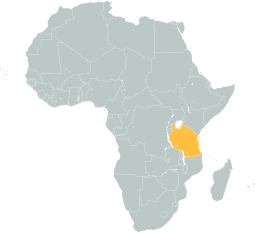
Home to Mount Kilimanjaro
Climbing Route
What are the best Kilimanjaro routes?
This question is hard to answer because each route has its own good and bad points. Here, we will answer some of the most common questions.
What is the best route to climb Mount Kilimanjaro?
For a quick answer, the Lemosho route is the favorite of Seko Tours Adventures and our clients. It offers excellent acclimatization, beautiful views, and the highest success rate according to our data from the past five years. However, it has become very popular recently and is now one of the top three busiest routes. If you prefer a more private experience, consider the 7-day Rongai route. Though it is not as scenic and lacks unique wildlife like Dendrosenecio kilimanjari, it is more than ten times less crowded than the popular routes.
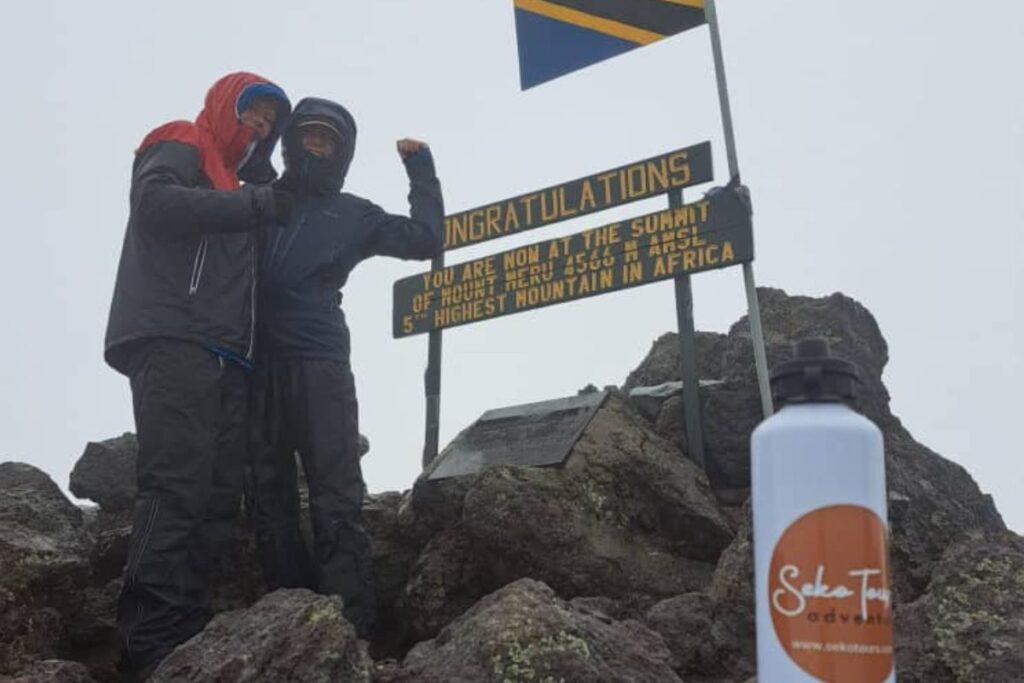
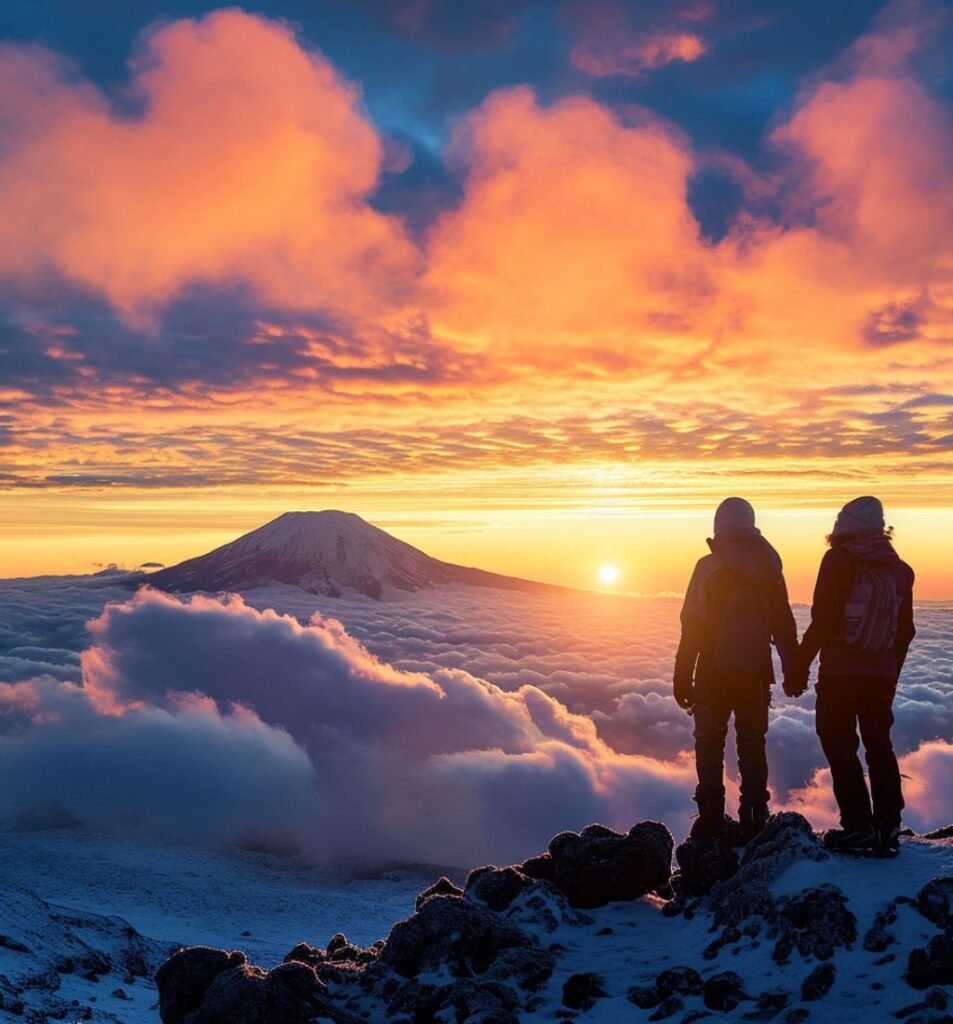
What is the easiest route to climb Kilimanjaro?
The main challenge on Mount Kilimanjaro is not the steep slopes or long daily hikes, but the altitude. Therefore, itineraries that offer the best acclimatization profiles might be considered the “easiest.” We recommend the Lemosho 7-8 day route and the Rongai 7 day route, with the Machame 7 day route and the Northern Circuit as good alternatives.
The 7-day Lemosho route is the easiest way up Mount Kilimanjaro for several reasons. Starting at 3,500 meters, it removes the need to climb to that altitude during the trek. Short initial daily hikes prevent overexertion, allowing your body to adapt to the altitude. All overnight stays are at or above 3,500 meters, which helps with acclimatization. Additionally, the route from Barafu Camp to the summit is the shortest, saving about an hour of travel time.
The Northern Circuit provides excellent acclimatization due to more days spent on the mountain, but it is better for hikers prepared for longer daily treks. For beginners, the Lemosho, Rongai, and Machame routes might be easier options with a higher chance of reaching the summit. If you need extra time to rest and acclimatize, you can add an extra acclimatization day at any camp to your itinerary.

Which Kilimanjaro route has the highest summit success rate?
According to Seko Tours adventure’s statistics, the 7 and 8-day Lemosho routes have the highest summit success rate at about 98%. Most climbers who choose these Lemosho itineraries reach the top. Why is this? The answer is simple: great acclimatization, many opportunities for “climb high, sleep low,” and enough time at altitude to adjust gradually. However, most itineraries that last 7 days or longer on the mountain also have high summit success rates.
Important note: summit success rates vary from operator to operator. A budget tour company might have inexperienced guides and poor equipment, reducing your chances of safely reaching Uhuru Peak. They often claim to have 95%+ summit success rates, but in reality, it is much lower.
On the other hand, a reputable operator will ensure you have the best chance of summiting and enjoy every detail of the experience. At Seko Tours, we stand by our commitment to excellence, with proven success rates of up to 98% on routes like Lemosho 7 and 8.
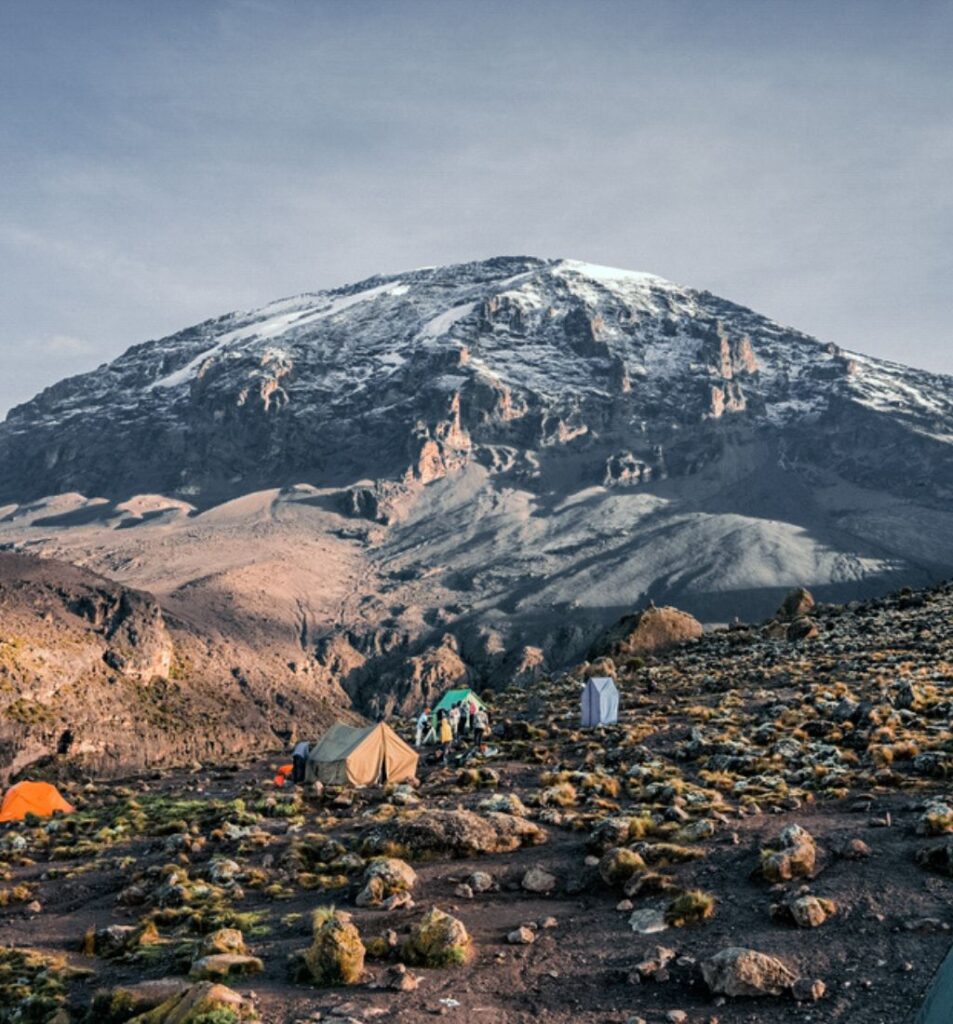
Conquering Kilimanjaro
AFRICA’S ICONIC MOUNTAIN
Experience the majesty of Mount Kilimanjaro, Africa’s iconic peak and the tallest freestanding mountain in the world. This towering volcanic wonder beckons adventurers with its challenging ascent and breathtaking views. Embark on a journey that transcends altitude, weaving through diverse ecosystems, from lush rainforests to alpine deserts. Summiting Kilimanjaro is not just a climb; it’s an odyssey, a test of endurance and a communion with the awe-inspiring beauty of the African continent. Every step is a revelation, every vista a reward, making the Kilimanjaro experience an unforgettable chapter in the book of your life’s adventures.
Everything you need to know about choosing the
perfect route for your Kilimanjaro adventure!
There are 8 main routes leading up the highest mountain in Africa – Kilimanjaro. Each Kilimanjaro route boasts its own set of benefits, whether it’s smoother acclimatization, breathtaking scenery, hut accommodations, or a quieter trekking experience. In this guide, we will help you choose the ideal route for your trip.
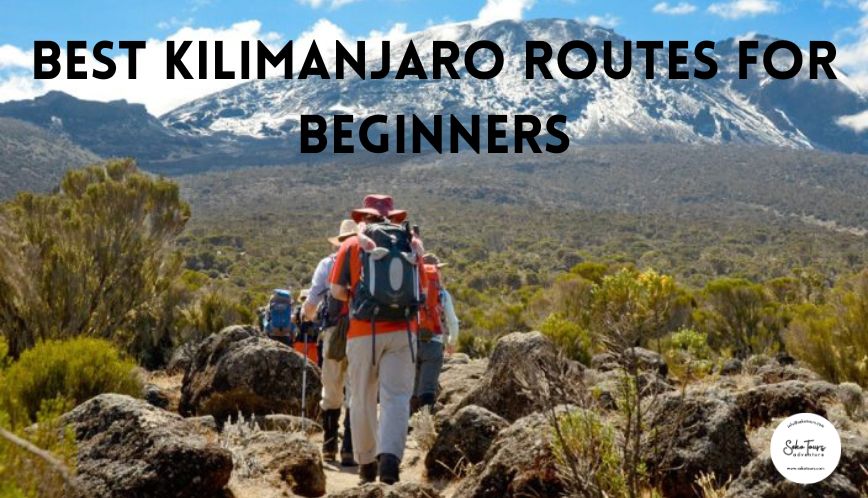
Popular questions about Kilimanjaro
Mount Kilimanjaro National Park is in northern Tanzania, East Africa. It is just three degrees south of the equator. While some of the most iconic panoramic shots of Mt. Kilimanjaro have been captured from the Kenyan side, all trailheads lie in Tanzania. Therefore, tourists can only climb Mt Kilimanjaro in Tanzania. The closest airport is Kilimanjaro International Airport.
Many Kilimanjaro expeditions begin in Moshi, the capital of the same region
Late December to early March and mid-June to late October are the best times for a Kilimanjaro climb. This is when the Kilimanjaro weather is nearly ideal.
Although other months have rain, it doesn’t mean there are constant heavy showers. Typically, rains begin in the latter half of the day. This allows trekkers a significant window of clear weather every day during the rainy season. There are also days without any rain. Seko Tours offers discounted climbs during the wet season.
You may read more about the seasons of Kilimanjaro.
Uhuru Peak, the summit of Mount Kilimanjaro, stands tall at 5,895 meters (19,341 feet). Yet, this doesn’t mean you’ll be starting your climb from the very base. Most hotels near Kilimanjaro are at an altitude of 700-1,000 meters above sea level. The trailheads begin at elevations of 1,600 meters and above.
Due to its altitude, Mt Kilimanjaro is among the few places in East Africa to see snow. The snow-capped peak of Kilimanjaro is truly a sight to behold!
We believe that after seeing it, Ernest Hemingway decided to name his famous story “The Snows of Kilimanjaro.” The title refers to the distant peak of Mount Kilimanjaro. It represents the unattainable, and the purity of idealist motives. In the story’s conclusion, the protagonist dreams of being taken to the summit of Kilimanjaro, symbolizing redemption.
The time it takes to climb Kilimanjaro depends on the route chosen. Most expeditions last 6 to 8 days. An experienced hiker with prior acclimatization usually climbs Kilimanjaro through an accelerated 5-day program. If you stay overnight in the crater, Kilimanjaro climbs can take 9 days or longer.
Among the Seven Summits, the Kilimanjaro trek is one of the shortest. For example, climbing Mount Everest takes 6-9 weeks, Denali and Aconcagua- 2-3 weeks. Kilimanjaro takes about one week only.
As of 2023, a comfortable and safe 7-day group climb costs about $2500-2700. A shorter 5-6-day adventure or a season-discounted trip comes at $2000-2300. This amount includes the park entrance fees, which make up about 40% of the total trip cost.
Any trekking companies offering below this amount should warrant caution. You may get low-quality guides and bad equipment. Such trips often lack medical kits and oxygen tanks, putting your safety at risk.
Also, low prices always correlate with the mistreatment of porters. None of those operators is a member of the KPAP. The crews of budget operators are often underpaid and poorly fed, putting their and hikers’ safety at risk.
Climbing Kilimanjaro is subject to the regulations of the Kilimanjaro National Park. The official rules dictate that a local guide must accompany all hikers. Rangers at the park will not permit entry to anyone without a professional Kilimanjaro guide.
Also, venturing up to the Roof of Africa solo involves certain risks. During the summit night in the peak zone, one may succumb to altitude sickness or get injured. If needed, the guides will assist with evacuations and other emergencies.
Finally, climbing Kilimanjaro is more than merely a physical challenge. You’ll go on a rich cultural journey with your guides. You will learn about Kilimanjaro’s plants, animals, and history. The guides will also share vibrant stories of the communities living in its shadow.
Anyone planning to climb Kilimanjaro should keep the park entrance fees in mind. As of today, they come at $140 per day per hiker. This amount includes several types of fees:
- ‘Conservation fees’ are for staying in the National Park and enjoying its nature.
‘Camping fees’, or ‘hut fees’ on the Marangu route. – The fees for pitching the tents or sleeping in the Marangu wooden cabins in the park.
‘Crew fees’ – there is a small charge for each crew member entering the National Park to support you on the trek.
‘Rescue fee’ – this is a sort of mandatory ‘insurance’ payment. The hikers pay it to use the Kilimanjaro rescue cars. Please keep in mind that this is not a substitute for a real insurance package.
Don’t worry about the park fees when planning your trip. Tour operators include them in the tour price and we will pay them to the park authorities on your behalf. Climbing Mount Kilimanjaro with Seko Tours you can be sure that we will take care of every detail.
Feature Travel Tips
See Our Basic Tanzania Travel Info
What Our Travelers Say
Read real stories from people who have traveled with Seko Tours Adventures. Our travelers talk about their unforgettable Tanzanian safari trips and explain why traveling with us is special and life-changing.
ExcellentBased on 9 reviews Verified
Verified James2024-07-04Unforgettable Kilimanjaro Trek . We hiked Mount Kilimanjaro with Seko Tours and it was unforgettable, thanks to our guide, David. He helped us every step of the way. The hike was hard, but David's help made it easier. We saw stunning views and finally reached the top. It was the best feeling ever. We couldn't have done it without David and the team at Seko Tours. Thank you for this amazing adventure.Verified
James2024-07-04Unforgettable Kilimanjaro Trek . We hiked Mount Kilimanjaro with Seko Tours and it was unforgettable, thanks to our guide, David. He helped us every step of the way. The hike was hard, but David's help made it easier. We saw stunning views and finally reached the top. It was the best feeling ever. We couldn't have done it without David and the team at Seko Tours. Thank you for this amazing adventure.Verified Darshan2024-07-03Amazing Kilimanjaro Hike . Climbing Mount Kilimanjaro with Seko Tours was amazing. Our guide, Inno, helped us a lot. He made sure we were ready for each day's hike. The views were beautiful and reaching the top was a dream come true. It was a hard climb, but Inno made it possible. This hike was one of the best experiences ever.Verified
Darshan2024-07-03Amazing Kilimanjaro Hike . Climbing Mount Kilimanjaro with Seko Tours was amazing. Our guide, Inno, helped us a lot. He made sure we were ready for each day's hike. The views were beautiful and reaching the top was a dream come true. It was a hard climb, but Inno made it possible. This hike was one of the best experiences ever.Verified Martelon2024-07-03We had a wonderful time on our safari with Seko Tours. We had a wonderful time on our safari with Seko Tours. Our guide, Ngoi, was excellent. He showed us many animals in the Ngorongoro Crater and the Serengeti. Ngoi was very patient and made sure we enjoyed our trip. The parks were beautiful and we saw so many animals. We highly recommend this tour and thank Ngoi for making it so special.Verified
Martelon2024-07-03We had a wonderful time on our safari with Seko Tours. We had a wonderful time on our safari with Seko Tours. Our guide, Ngoi, was excellent. He showed us many animals in the Ngorongoro Crater and the Serengeti. Ngoi was very patient and made sure we enjoyed our trip. The parks were beautiful and we saw so many animals. We highly recommend this tour and thank Ngoi for making it so special.Verified Navigate S2024-07-03Great Safari Adventure . Our safari with Seko Tours was fantastic, thanks to our guide, David. He was very friendly and knew so much about the animals. We saw giraffes, zebras, and hippos in the national parks. David made sure we got the best views and told us many interesting facts. The lodges were nice and the food was tasty. We had so much fun. Thank you, David and Seko Tours, for an amazing adventure!.Verified
Navigate S2024-07-03Great Safari Adventure . Our safari with Seko Tours was fantastic, thanks to our guide, David. He was very friendly and knew so much about the animals. We saw giraffes, zebras, and hippos in the national parks. David made sure we got the best views and told us many interesting facts. The lodges were nice and the food was tasty. We had so much fun. Thank you, David and Seko Tours, for an amazing adventure!.Verified Obazee2024-07-02Amazing Safari Experience . "We went on a safari with Seko Tours and it was amazing. Our guide, Inno, was great. He knew a lot about the animals. We saw lions, elephants, and a cheetah in the Serengeti. Inno made sure we were always comfortable. This safari was the best ever, thanks to Inno and Seko Tours!"Verified
Obazee2024-07-02Amazing Safari Experience . "We went on a safari with Seko Tours and it was amazing. Our guide, Inno, was great. He knew a lot about the animals. We saw lions, elephants, and a cheetah in the Serengeti. Inno made sure we were always comfortable. This safari was the best ever, thanks to Inno and Seko Tours!"Verified Rony V2023-12-27Safari with guide Ezekiel. Ezekiel was a perfect guide and driver. He made us visit and discover the real wildlife of Tanzania. No trouble was too much for him. His knowledge about all the hotspots of the different animals is amazing. Haruna matata, he gets you around.Verified
Rony V2023-12-27Safari with guide Ezekiel. Ezekiel was a perfect guide and driver. He made us visit and discover the real wildlife of Tanzania. No trouble was too much for him. His knowledge about all the hotspots of the different animals is amazing. Haruna matata, he gets you around.Verified Romy H2023-11-28Unforgettable experience at Mount Meru! We climbed Mount Meru in 4 days with Happyson and his crew from Seko Tours. We had an amazing experience, even though it was quite tough (especially because of the rainy season). We made it to the top thanks to this wonderful crew. They even shared their rain jacket and waterproof gloves with us. The chef prepared delicious meals, and the waiter took great care of us (including water to wash ourselves, tea, popcorn and hot water in a bottle to keep us warm during the night). Happyson and team spared no efforts and we had a lot of fun together. On the fourth day, right before the gate, we were surprised by seeing so many wild animals and the beautiful waterfall. The two giraffes at just a few meters away was amazing. Would definitely recommend!!Verified
Romy H2023-11-28Unforgettable experience at Mount Meru! We climbed Mount Meru in 4 days with Happyson and his crew from Seko Tours. We had an amazing experience, even though it was quite tough (especially because of the rainy season). We made it to the top thanks to this wonderful crew. They even shared their rain jacket and waterproof gloves with us. The chef prepared delicious meals, and the waiter took great care of us (including water to wash ourselves, tea, popcorn and hot water in a bottle to keep us warm during the night). Happyson and team spared no efforts and we had a lot of fun together. On the fourth day, right before the gate, we were surprised by seeing so many wild animals and the beautiful waterfall. The two giraffes at just a few meters away was amazing. Would definitely recommend!!Verified Avdb2023-10-28Safari with David from Seko tours David was our guide for our 2 day Tarangire and 1 day Ngorongoro safari. We were with a group of 4 friends and David was the best guide we could wish for. He had a lot of knowledge about the area, the animals, the culture, actually about everything. He could find every amimal we wanted to see including the difficult to spot cheeta, leopard and rhino. He did everything to get us the best spot to view and photograph the animals. When viewing, he told us a lot of intersting facts about the animals and the area they are in. Between the safari days David also was our driver to all locations in between, always on time and always with surprises, like beer or a great warm lunch. Thanks David you made our trip really worth it!!Verified
Avdb2023-10-28Safari with David from Seko tours David was our guide for our 2 day Tarangire and 1 day Ngorongoro safari. We were with a group of 4 friends and David was the best guide we could wish for. He had a lot of knowledge about the area, the animals, the culture, actually about everything. He could find every amimal we wanted to see including the difficult to spot cheeta, leopard and rhino. He did everything to get us the best spot to view and photograph the animals. When viewing, he told us a lot of intersting facts about the animals and the area they are in. Between the safari days David also was our driver to all locations in between, always on time and always with surprises, like beer or a great warm lunch. Thanks David you made our trip really worth it!!Verified Cindy V2023-07-24Best Safari guides with a lot of knowledge, friendliness and fun We had a wonderful experience with our guides Shabani (mr walking encyclopedia) and John (mr juice). We went to Tarangiri, Serengeti and Ngorogoro in 2 cars with a family of 7. Both guides learned us a lot on the animals and really were motivated to give us the best time possible. They are friendly, happy and the best guides you could wish for. We saw all animals we wanted to see multiple times and had a lot of fun together.
Cindy V2023-07-24Best Safari guides with a lot of knowledge, friendliness and fun We had a wonderful experience with our guides Shabani (mr walking encyclopedia) and John (mr juice). We went to Tarangiri, Serengeti and Ngorogoro in 2 cars with a family of 7. Both guides learned us a lot on the animals and really were motivated to give us the best time possible. They are friendly, happy and the best guides you could wish for. We saw all animals we wanted to see multiple times and had a lot of fun together.
